Chillon Castle
| Château de Chillon | |
|---|---|
 View from the north, with the Dents du Midi in the background | |
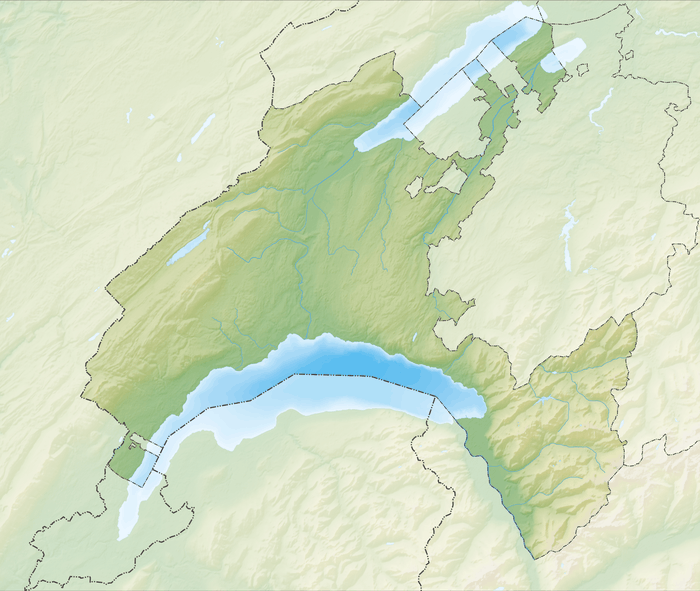 Location within Canton of Vaud  Chillon Castle (Switzerland) | |
| General information | |
| Architectural style | Medieval |
| Classification | Historic monument |
| Town or city | Veytaux |
| Country | Switzerland |
| Coordinates | 46°24′51″N 6°55′39″E / 46.414167°N 6.9275°E |
Chillon Castle (French: Château de Chillon) is an island castle located on Lake Geneva (Lac Léman), south of Veytaux in the canton of Vaud. It is situated at the eastern end of the lake, on the narrow shore between Montreux and Villeneuve, which gives access to the Alpine valley of the Rhône. Chillon is amongst the most visited castles in Switzerland and Europe.[1]
History
Chillon began as a Roman outpost, guarding the strategic road through the Alpine passes.[2] The later history of Chillon was influenced by three major periods: the Savoy Period, the Bernese Period, and the Vaudois Period.[3]
Savoy period
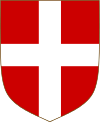
The oldest parts of the castle have not been definitively dated, but the first written record of the castle is in 1005.[4] It was built to control the road from Burgundy to the Great Saint Bernard Pass[5] From the mid 12th century, the castle was summer home to the Counts of Savoy, who kept a fleet of ships on Lake Geneva. The castle was greatly expanded in 1248[6] by Peter II.[7]
Chillon as a prison
During the 16th century Wars of Religion, it was used by the dukes of Savoy to house prisoners. Its most famous prisoner was probably François de Bonivard, a Genevois monk, prior of St. Victor in Geneva and politician who was imprisoned there in 1530 for defending his homeland from the dukes of Savoy.[8]
Bernese period
Over his six-year term, de Bonivard paced as far as his chain would allow, and the chain and rut are still visible. He was rescued in 1536 by his countrymen and Bernese, who took the castle by force. The prison was residence for the Bernese bailiff until Chillon was converted into a state prison in 1733.[9]
Vaudois period
In 1798, the French-speaking canton of Vaud drove out the German-speaking Bernese authorities and declared the Lemanic Republic. The Vaudois invited in French troops to help them maintain autonomy from the other Swiss. When the French moved in and occupied, Chillon was used as a munitions and weapons depot.[10]
Today
Chillon is open to the public for visits and tours. According to the castle website, Chillon is listed as "Switzerland's most visited historic monument".[11] There is a fee for entrance and there are both parking spaces and a bus stop nearby for travel. Inside the castle there are several recreations of the interiors of some of the main rooms including the grand bedroom, hall, and cave stores. Inside the castle itself there are four great halls, three courtyards, and a series of bedrooms open to the public. One of the oldest is the Camera domini, which was a room occupied by the Duke of Savoy - it is decorated with 14th century medieval murals.[12]
Popular culture
Chillon is the setting of Lord Byron's poem The Prisoner Of Chillon (1816) about François de Bonivard. Byron also carved his name on a pillar of the dungeon.
The castle is also one of the settings in Henry James's novella Daisy Miller (1878).
Chillon inspired the castle in the Disney animated film The Little Mermaid.[13]
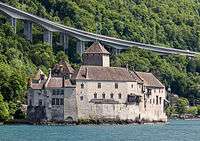 Chillon Castle and Motorway
Chillon Castle and Motorway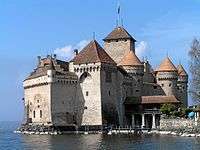 From the south
From the south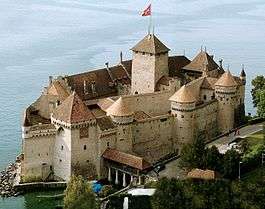 From above
From above- Front
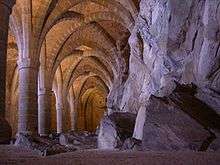 Chillon Castle crypt
Chillon Castle crypt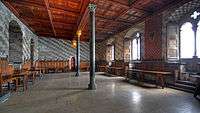 Grand Hall of the Count
Grand Hall of the Count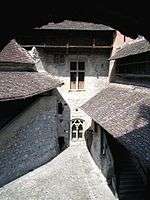 The castle courtyard
The castle courtyard Byron's signature in the dungeon
Byron's signature in the dungeon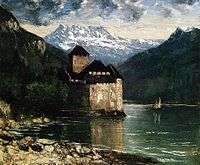 Chateau du Chillon by Gustave Courbet, 1875
Chateau du Chillon by Gustave Courbet, 1875- Chillon Castle, aerial view
See also
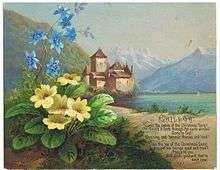
- Fort de Chillon – a 20th century fort largely buried in the adjoining hillside
- List of castles in Switzerland
Notes
- ↑ Mc Currach, Ian (27 April 2003). "One Hour From: Geneva". The Independent. London. Retrieved 2014-07-30.
- ↑ de Fabianis, p. 176.
- ↑ "Château de Chillon - History overview". Chillon.ch. Retrieved 2013-01-13.
- ↑ According to publication Chillon by Auguste Guignard (former secretary of the Association for the Restoration of the Chillon Castle), published by Ruckstuhl SA (Renens, Switzerland) in 1996: "The oldest historical document relating to Chillon bears the date 1005, and from this it is seen that the castle belonged to the bishops of Sion, who confided its care to the d'Alinge family."
- ↑ de Fabianis, p. 175.
- ↑ de Fabianis, p. 175.
- ↑ Cox 1967, p. 20.
- ↑ de Fabianis, p. 175.
- ↑ de Fabianis, p. 175.
- ↑ de Fabianis, p. 175.
- ↑ "Chillon Website - Main Page". Chillon.ch. Retrieved 2013-01-13.
- ↑ "Chillon Website - Rooms". Chillon.ch. Retrieved 2013-01-13.
- ↑ Morton, Caitlin (14 June 2017). "17 Real-World Locations That Inspired Disney Movies". Condé Nast Traveler. Retrieved 3 April 2018.
References
External links
| Wikisource has original text related to this article: |
| Wikimedia Commons has media related to Château de Chillon. |